Nonce Words.Nonce season. And last but not least-Nonce Art!
“The time has come to talk of many things…of cabbages and sealing wax”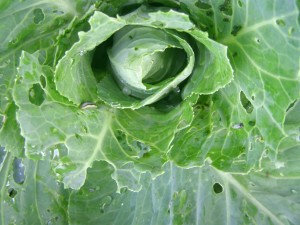
| “A nonce word is one coined ‘for the nonce’–made up for one occasion and not likely to be encountered again. Milling around”to move around in churning confusion” with no pattern in particular. |
Winter is always odd for me an almost un real period-Things done, but not repeatable or even wanting to be repeated. A period of waiting for the reality and often much milling around. Many things get done.Many goals are accomplished, but not the ones that make one feel like one has accomplished something or are-at least moving towards a p articular goal.Things feel/are so disjointed My next pieces– actually two pieces of both of my Grandmothers. AND, no, it’s not seasonal light disorder thingy, because I am a true pluviophile.
articular goal.Things feel/are so disjointed My next pieces– actually two pieces of both of my Grandmothers. AND, no, it’s not seasonal light disorder thingy, because I am a true pluviophile.
| Pluviophile;(n) a lover of rain; someone who finds joy and peace of mind during rain and rain storms. |
The images I want to weave are just out of reach. Milling around –waiting, elusive, a pile of images, nightmares, dreams, drawings and things, floating looking for an anchor point in the design. At this point it all seems to be in a language not my own and It’s all jabberwocky speak…It seems.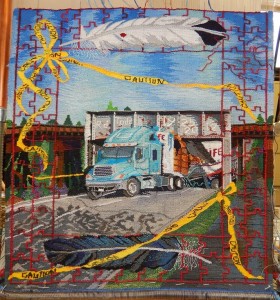
Dad’s piece almost finished.Will be done by tomorrow so I can take it on my travels.
AND- I leave next week to
teach in Sedona, AZ. AND, I will get to spend a couple of days with my friend Diane Kennedy just looking at stuff, visiting and perhaps a bit of weaving. I will definitely make it over to Santa Fe for a day or so. I am returning by train. The snow should be beautiful in the Mountains. I am so ready for a break and so tired of waiting for the other shoe to fall. It’s all so tax season. Spencer works from 8AM to 9PM+ during peak times. He did remember I was alive to day. I found a huge bouquet of flowers on my door step. Doesn’t get better then that on Valentines Day. The smell is incredible and best of all doesn’t smell like construction smells.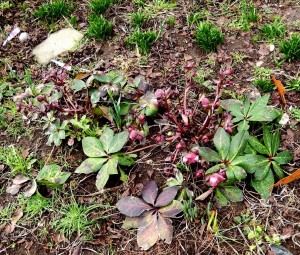
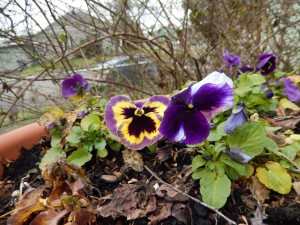
Two amazing Things-Hellebore’s and Pansies- that don’t realize that they were just covered with 18-24 inches of snow and ice. 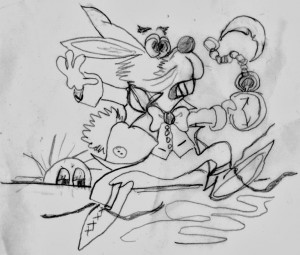 Fortunately and Sometimes unfortunately, everything(time included)else is moving on. The house is almost insulated-what can be done from the inside. We decided after the freaking cold Nov. and Dec that it would probably be a good idea. Of course, not counting on a
Fortunately and Sometimes unfortunately, everything(time included)else is moving on. The house is almost insulated-what can be done from the inside. We decided after the freaking cold Nov. and Dec that it would probably be a good idea. Of course, not counting on a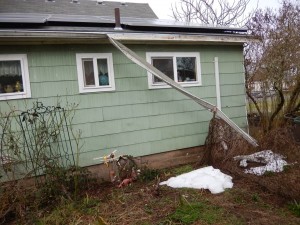 snow and ice storm that made it virtually impossible to work outside.Anything that can be insulated from inside was finished yesterday. The outside blow-in of insulation has been started and stopped-2/3rds- because of heavy snow fall, ice and now really heavy rains-almost here. MORE! Added
snow and ice storm that made it virtually impossible to work outside.Anything that can be insulated from inside was finished yesterday. The outside blow-in of insulation has been started and stopped-2/3rds- because of heavy snow fall, ice and now really heavy rains-almost here. MORE! Added 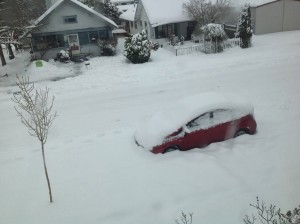 hours because the snow and ice pulled off the eaves troughs. Of course, that’s what happens when a house is built with square nails and no screws in the 1880’s. I have learned more about
hours because the snow and ice pulled off the eaves troughs. Of course, that’s what happens when a house is built with square nails and no screws in the 1880’s. I have learned more about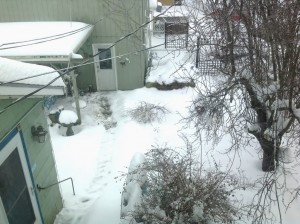 construction then I ever wish to know-especially antique vs. new construction. These pictures were taken before the next 8 inches fell.
construction then I ever wish to know-especially antique vs. new construction. These pictures were taken before the next 8 inches fell.
It’s definitely time for a break- The first one happens next week. I will be teaching in
Sedona, AZ. After the workshop I’ll be around the area and will then visit with friends in Santa Fe and other places. My itinerary and schedule will be rather freeform and very loose.
| My lecture “The life and times of me myself and I”-will be after the Verde Valley Weavers meeting on February 20, 2014. At St. Andrews Episcopal church, located at 100 Arroyo Pinion Dr. in Sedona, AZ. Meeting starts at 10:00 AM and should be over by 11:00. With warping looms after lunch, then come back to the church to warp our looms the next three days will be My Tapestry workshop More! starting at 9:30 AM. If you need instructions or would like to join the class to either of these places, please call 928-639-2781. |
Another break I will be taking will be teaching in Cincinnati and the class has been opened up for registration of non-guild members.Around the last of March I will be teaching my More! workshop in Cincinnati. It’s one of my favourite classes to teach because it builds on what the student knows technically and how to use those skills and add to those skills to create complexity and detail to their designs. That class has now been opened up to people outside the guild to register. There are only a couple of spaces left. I will also be giving a presentation called “The life and times of Me, Myself and I.” It includes a portion on my design process.
| Weavers Guild of Greater Cincinnati Membership program lecture 10:00AM.“ME, Myself, and I (and my design process) Workshop-MORE! April 3-5, 2014 More is about taking beginning tapestry techniques, or not so beginning to the next level and discipline the technique achieve the effects you want in your design.Class covers bobbin blending, hachures, hatching, soumack, combining all of the techniques together as needed, a little design and many other techniques and techniques that the participants would like to focus on. If your interested in taking the workshop contact-Cheryl Muckenfuss; e-mail spin.weave.cheryl@gmail.com or myself. |
One more thing- before
I get to
the tapestry techie stuff!
I love Tapestry history. One of things that rarely 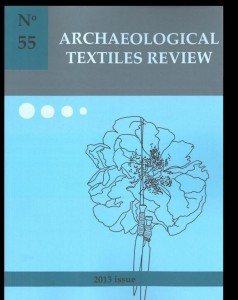 happens is for someone to write on historical technique or tools or there usage.
happens is for someone to write on historical technique or tools or there usage.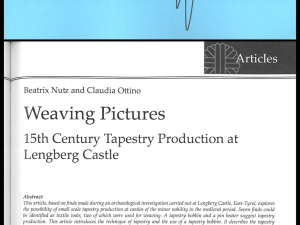
This is a very interesting article on the history of bobbins and how they are used. The Cover was borrowed from an outline of one of my tapestry. The article is well illustrated with many historical examples and less historical pictures of my using bobbins on my tapestry And He…I was extremely pleased to be able to supply a bit of information on contemporary usage of bobbins. It’s a fascinating article and the research that MS. Nutz has done to produce the article make it well worth reading. IF your interested in reading the article and having trouble finding it let me know and we can work. Something out.
(There will eventually be a url to the article, but it’s beyond my capabilities. So Pat graciously agreed to help me figure it out tomorrow.)
Handling slits. Decisions that can really be tough in Tapestry.
Consideration What am I willing to tolerate? 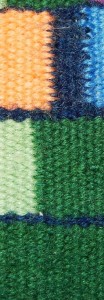 How do I want to handle a slit-toothed, stair-stepped or smooth?The handling or weaving is the easy part, but design wise there are a lot of choices one needs to make-especially when weaving small format small scale work.On a large format tapestry viewers stand far enough away from the tapestry that your brain will perseverate and basically see what it thinks it should see. In the case of slits the toothing that runs between the two join
How do I want to handle a slit-toothed, stair-stepped or smooth?The handling or weaving is the easy part, but design wise there are a lot of choices one needs to make-especially when weaving small format small scale work.On a large format tapestry viewers stand far enough away from the tapestry that your brain will perseverate and basically see what it thinks it should see. In the case of slits the toothing that runs between the two join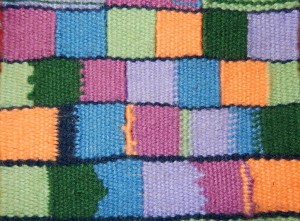 need sides of the slit will be seen as a smooth line simply blending one tooth into another because your brain is insistent on seeing what it wishes to see in redundant repetitious things. Trouble is with small format’’/small scale work people just stand to close to examine the work. This may or may not be a thing that is related to optical blending- The reason a chene will blend into one colour instead of many. This is one of those things that drives me bonkers. Traditionally when you wanted to get rid of long slits the design was turned sideways so that
need sides of the slit will be seen as a smooth line simply blending one tooth into another because your brain is insistent on seeing what it wishes to see in redundant repetitious things. Trouble is with small format’’/small scale work people just stand to close to examine the work. This may or may not be a thing that is related to optical blending- The reason a chene will blend into one colour instead of many. This is one of those things that drives me bonkers. Traditionally when you wanted to get rid of long slits the design was turned sideways so that 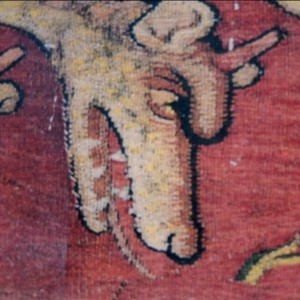 major slits would not happen, but most would fall between or along the fell line or verge. Well-maybe in a perfect world, but it never seems to happen with my designs major slits run both directions in almost all of my tapestries. So, it usually breaks down to which direction to I prefer
major slits would not happen, but most would fall between or along the fell line or verge. Well-maybe in a perfect world, but it never seems to happen with my designs major slits run both directions in almost all of my tapestries. So, it usually breaks down to which direction to I prefer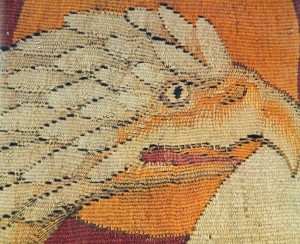 to work the design and how can I manipulate it to my advantage- Note the dark toothed line used as an outline in the dragons head. Or the pulled slits to create shadows and textures in the eagles.
to work the design and how can I manipulate it to my advantage- Note the dark toothed line used as an outline in the dragons head. Or the pulled slits to create shadows and textures in the eagles.
I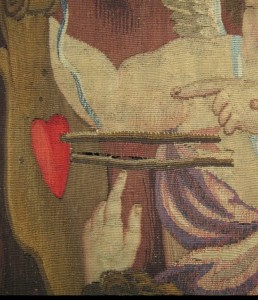 Possible traditional reason for sewing slits on the other hand the top bar shows another reason you might not want to stitch, but perhaps as likely just a weaves choice. Not the toothing on the top bolt and the unsewn edge on the bottom bolt. Note single line of sewn wrap on eagles bill and the toothed joins where the yellow and red come together on the neck.
Possible traditional reason for sewing slits on the other hand the top bar shows another reason you might not want to stitch, but perhaps as likely just a weaves choice. Not the toothing on the top bolt and the unsewn edge on the bottom bolt. Note single line of sewn wrap on eagles bill and the toothed joins where the yellow and red come together on the neck.
There are a lot of things you can do with slits. They can be overlapped. Silvia Hayden’s works has great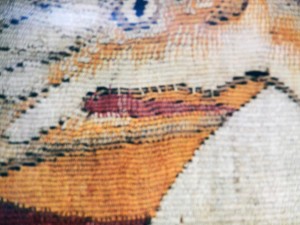 examples of that or they can be pulled. I dislike sewing slits because they always seem to eventually show or work their way to the surface even though I have some very good ways to sew slits.
examples of that or they can be pulled. I dislike sewing slits because they always seem to eventually show or work their way to the surface even though I have some very good ways to sew slits. 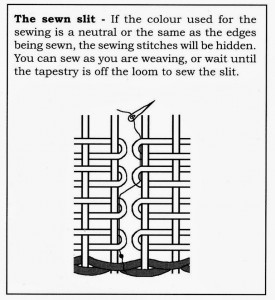
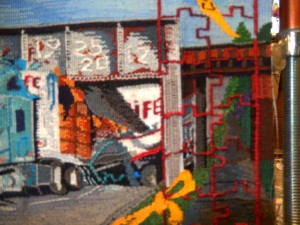
So Why is this on my mind? I always have a critique of my finished weaving and things that I might have, could have, or should have done better. Basically, about deciding if I like what I did or will I change my approach on the next piece.
On my Dad’s piece I had 3 major areas of slits or not having slits and lots of areas where I need to determine how to to treat the edge of a slit as a structural design element. 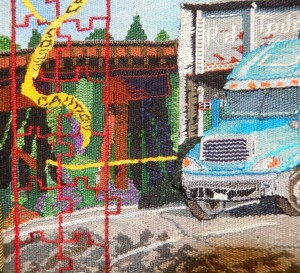
So the determining factors in the direction that I wove this tapestry were the trestle itself and the feather quills.-Which direction would any stair stepping be less noticeable. And, of Course the uprights on the truck cab-but less so.
Should I weave this way-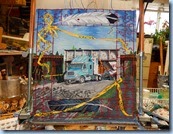
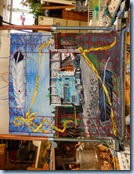 or this way?
or this way?
Things to be aware of when weaving long slits-
1. first and foremost for me is the toothing and stair-stepping. IT determines whether I sew,which joins I use and the detail of the techniques used around the slit.-Laced edge pulled edge, overlapped edge, fine line between slits(sewn with a contrasting colour for fine line or left open to create a shadow, toothed joins or which joins to use.
2. Long slits can distort and stretch the warp with over use. The buckle is caused by the stretching and when it stretches one can get more passes in a given area that won’t shrink back as the stretching lessens over time. This use can make the slit longer then the area around it. So it buckles the tapestry in the area between two slits.
3.Occasionally the slit edges will roll along the edge of the slit. When ever possible make the edge of the slit on a valley thread.
Not always possible. And/or change the direction the weft is traveling every .5 inches or less depending on the warp sett. It’s just a pigtail loop to the the other side, pigtail and take off weaving in the opposite direction.
4. The turns even when weaving way above the normal fell line should be exactly half of the distance between the two warps.So that they won’t distort the line of the slit .
5. Measure the width constantly and correct as soon as possible- if a problem is starting.. In long slitted areas. It’s very easy to begin to use too big of a bubble or not a enough bubble. Watch that the fell line doesn’t curve up or down. Both indications of too little or two much weft. Remember the old seam gauges with the sliding metal mark thingy. Works wonderful to measure areas and the movable edge doesn’t slide so you don’t have to constantly try and remember how wide or something was suppose to be.
http://members.peak.org/~spark/ArcheologicalReviewArticle.html6 In very long slits that are sewn as you weave Stabilize the slits by bas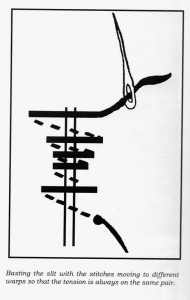 ting.
ting.
7 Needles can be left hanging while weaving and picked up as needed by tying a small knot around the needles eye.
8. Watch the colour you sew the slit with. in time there is always a small amount of movement of the weft up and down the warps. Choice neutrals and usually not white. Sew when ever possible like to like. Never pierce a warp thinking it will stabilize the slit.
Well, you have finally
reached the end of 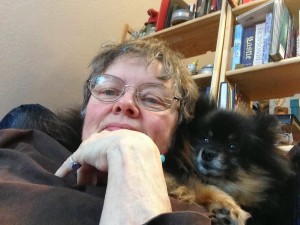 another one
another one
of my blogs. Chene and I are off to read a book.
Oh-shoot-that was meant to go to the private blog.
I took your advice and checked the blog. Took me a while to figure out where the post were. Boy am I embarrassed-more later!! I had no idea the post were there. i thought the blog was suppose to notify me when there were posts. Thanks for the comments on Dd's piece-first time in my life that I have piece and can't figure out a title for it. It is the start of new narrative. I am again a first time having a terrible time with the images and symbols for the next piece. How does one come up with one for something so totally horrific, but semi hide it at the same time?
kathe
Kathe, great post once again. Your Father's tapestry is a wonderful story, it needed to be told/woven.
Enjoy your travels and teaching schedule.
(do check the blog)
Patti Kirch,
Thanks for the slit information!
This is the link to the article.
http://members.peak.org/~spark/ArcheologicalReviewArticle.html
kathe